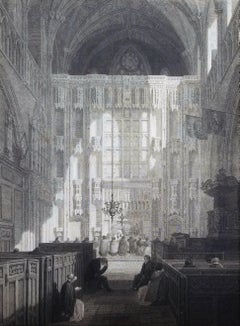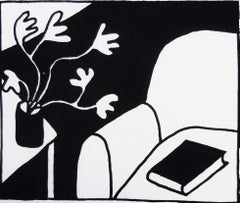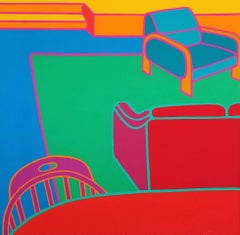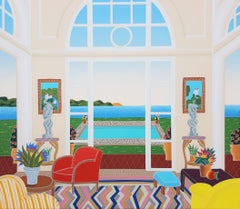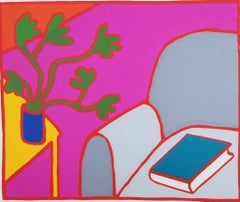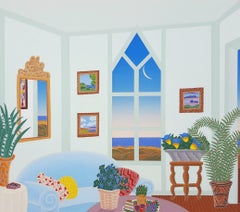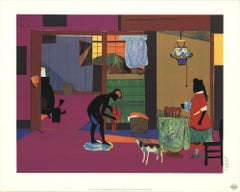Graves International Art Interior Prints
to
3
2
1
Overall Width
to
Overall Height
to
5
1
3
2
1
5
5
4
2
2
2
2
2
1
1
1
1
1
1
1
1
1
1
1
1
1
1
1
1
5
1
1
6
St. Alban's Abbey Church, High Altar screen /// Robert Clutterbuck Hertford Art
Located in Saint Augustine, FL
Artist: Robert Clutterbuck (English, 1772-1831)
Title: "St. Alban's Abbey Church, High Altar screen"
Portfolio: The History and Antiquities of the County of Hertford
Year: 1815-1827 (First edition)
Medium: Original Engraving on wove paper
Limited edition: Unknown
Printer: Nichols, Son, and Bentley, London, UK
Publisher: Nichols, Son, and Bentley, London, UK
Reference: Brunet II, No. 112; Lowndes No. 483; BAL RIBA No. 666; Upcott I, page 623
Sheet size: 17.63" x 11.38"
Image size: 11.57" x 8.57"
Condition: Scattered foxing throughout sheet; it doesn't show much within the image. Creasing to upper left and right corners. Has been professionally stored away for decades. It is otherwise a strong impression in good condition
Notes:
Provenance: private collection - Aspen, CO. Engraved by English artist John Henry Le Keux (1812-1896) after a drawing by English artist Frederick Nash (1782-1856). Comes from Clutterbuck's three volume "The History and Antiquities of the County of Hertford", (1815-1827) (First edition), which consists of 54 engravings. Printed from one copper plate on one color: black. "Vol. I. p. 65" printed upper right in margin. "Proof" printed lower right in margin.
St Albans Cathedral, officially the Cathedral and Abbey Church of St Alban, also known as "the Abbey", is a Church of England cathedral...
Category
1810s Old Masters Interior Prints
Materials
Engraving, Intaglio
Book on Chair (Black) /// Contemporary Pop Art Screenprint Interior Home Plant
By Dan May
Located in Saint Augustine, FL
Artist: Dan May (American, 1955-)
Title: "Book on Chair (Black)"
*Signed and numbered by May in pencil lower left
Year: 1988
Medium: Original Screenprint on unbranded white wove pape...
Category
1980s Contemporary Interior Prints
Materials
Screen
Living Room /// Contemporary Pop Art Screenprint Interior Colorful Chair Sofa
By Dan May
Located in Saint Augustine, FL
Artist: Artist: Dan May (American, 1955-)
Title: "Living Room"
*Signed and numbered by May in pencil lower left
Year: 1981
Medium: Original Screenprint on unbranded white wove paper
...
Category
1980s Contemporary Interior Prints
Materials
Screen
Sag Harbor /// Contemporary Thomas McKnight Screenprint Hamptons NY Modern Art
By Thomas McKnight
Located in Saint Augustine, FL
Artist: Thomas McKnight (American, 1941-)
Title: "Sag Harbor"
Portfolio: The Hamptons
*Signed by McKnight in pencil lower right
Year: 1987
Medium: Original ...
Category
1980s Contemporary Interior Prints
Materials
Screen
Book on Chair /// Contemporary Pop Art Screenprint Interior Flowers Colorful
By Dan May
Located in Saint Augustine, FL
Artist: Dan May (American, 1955-)
Title: "Book on Chair"
*Signed and numbered by May in pencil lower left
Year: 1989
Medium: Original Screenprint on unbranded white wove paper
Limite...
Category
1980s Contemporary Interior Prints
Materials
Screen
Sagaponack /// Contemporary Thomas McKnight Screenprint Hamptons NY Modern Art
By Thomas McKnight
Located in Saint Augustine, FL
Artist: Thomas McKnight (American, 1941-)
Title: "Sagaponack"
Portfolio: The Hamptons
*Signed by McKnight in pencil lower right
Year: 1987
Medium: Original Screenprint on soft-white Somerset paper
Limited edition: 143/175, (there were also 40 artist's proofs)
Printer: Willco Fine Art, New York, NY
Publisher: Chalk & Vermilion, New York, NY
Sheet size: 21" x 23"
Image size: 16" x 18.13"
Condition: Never framed, has been professionally stored away in its original green silk boxed portfolio for decades. In mint condition
Notes:
Numbered by McKnight in pencil lower left. Comes from McKnight's 1987 "The Hamptons" portfolio of twelve screenprints. Artist's copyright stamp lower right on verso.
Biography:
Thomas McKnight (born 1941) is a U.S. artist. He was born in 1941 in Lawrence, Kansas. He attended Wesleyan University, a small liberal arts college in Middletown, Connecticut, where he was one of only five art majors. He spent his junior year in Paris. After a year of graduate work in art history at Columbia University, in 1964 McKnight found a job at Time Magazine where he would work for eight years, interrupted by a two-year stint in the U. S. Army in South Korea. In 1972 McKnight left Time, summered on the Greek island of Mykonos, and commenced painting in earnest. In 1979 in Mykonos, McKnight met Renate, a vacationing Austrian student, and married the following year. Throughout the 1980s McKnight’s art, mainly limited edition serigraph prints, became increasingly popular. In 1994 he was commissioned by the White House to paint the first of three images for President Clinton...
Category
1980s Contemporary Interior Prints
Materials
Screen
Related Items
Shepard Fairey "Paint It Black" Letterpress Edition Contemporary Rolling Stones
By Shepard Fairey
Located in Draper, UT
I've made a few Paint it Black themed images and this letterpress print was made especially for my New Clear Power show at AMUSEUM in Munich, Germany.
Unfortunately, the topic r...
Category
2010s Contemporary Interior Prints
Materials
Screen
Bearden-Mecklenburg Morning: Sunrise for China Lamp Serigraph
By (after) Romare Bearden
Located in Brooklyn, NY
This vibrant recreation of Romare Bearden's work, titled Mecklenburg Morning: Sunrise for China Lamp, was published by American Vision Gallery Inc. and reproduced with the consent of...
Category
1990s Contemporary Interior Prints
Materials
Screen
$2,800 Sale Price
20% Off
H 35 in W 43.75 in D 0.1 in
S. Paolo Fuori Le Mura (Vedute della Basilica di S. Paolo fuor della mura)
By Giovanni Battista Piranesi
Located in Fairlawn, OH
S. Paolo Fuori Le Mura (Vedute della Basilica di S. Paolo fuor della mura)
Etching, 1748
From: Vedute di Roma, Plate 8
An early Roman printing, published by Bouchard e Gravier
Watermark: Fleur de Lys in a double circle
Signed in the plate
Condition: Small margins as are common with Bouchard published impressions.
Centerfold (as usual)
Rich impression with good contrasts
Plate/Image size: 15 7/8 x 24 1/8 inches
Sheet size: 17 3/8 x 24 3/4 inches
Reference: Focillon 723
Wilton-Ely 138
Hind 6 ii/VI, Bouchard e Gravier printing, before the price and numbers in later states
This image is Piranesi’s second interior scene from the Vedute di Roma. The first interior is a less complex composition of the Interior of St. Peters which lacks the challenging perspective that the artist masters in this image.
The Papal Basilica of St. Paul Outside the Walls...
Category
1740s Old Masters Interior Prints
Materials
Etching
$2,000
H 15.88 in W 24.13 in
The So-Called Tempio della Tosse, Near Tivoli. Interior Upright
By Giovanni Battista Piranesi
Located in Fairlawn, OH
The So-Called Tempio della Tosse, Near Tivoli. Interior Upright (Veduta interna del Tempio della Tosse)
"Temple of the Cough"
Etching, 1764
Signed in the plate
From: Vedute di Roma...
Category
1760s Old Masters Interior Prints
Materials
Etching
$2,750
H 24.75 in W 18.25 in
Original AJANTA INDIA Bodhisattva Padmapani vintage travel poster 1959
Located in Spokane, WA
Original Ajanta India vintage travel poster from 1959. Archival linen backed in Grade A condition, ready to frame. Note that a later edition of this poster was printed but the im...
Category
1950s Old Masters Figurative Prints
Materials
Lithograph
$995
H 39.5 in W 24.25 in D 0.3 in
'Jesus and the Woman at the Well, ' by Amand-Durand, Engraving
By Armand Durand
Located in Oklahoma City, OK
This early 19th century framed 35" x 31" engraving by artist Amand-Durand depcits an etching of 'Jesus and the Woman at the Well,' after the Dutch master, Rembrandt van Rijn. This poignant Biblical story is depicted by Arman-Durand in Rembrandt style...
Category
Early 19th Century Old Masters Figurative Prints
Materials
Engraving
$1,200 Sale Price
20% Off
H 30.5 in W 26.5 in D 1.5 in
Church of St. Costanza, Rome: An 18th Century Piranesi Architectural Etching
By Giovanni Battista Piranesi
Located in Alamo, CA
This is a framed 18th century Giovanni Battista Piranesi etching entitled: "Veduta interna del Sepocro di Santa Costanza, fabbricat...
Category
1770s Old Masters Interior Prints
Materials
Etching
$3,775
H 27 in W 32 in D 1.5 in
Carcere ascura
By Giovanni Battista Piranesi
Located in Fairlawn, OH
Carcere ascura
Etching, 1743
Signed in the plate bottom left corner
From: Prima Parte, 1743
Second edition: 1750-1778
Watermark: R 37-39
A lifetime impression printed during Piranesi’s life, before the plates are moved to Paris by his sons in the 1790’s
This image foretells Piranesi's famous set, Carceri (Prisons) which is his next creative effort.
Condition: Horizontal crease midway in the sheet associated with the manufacture of the paper.
Visible watermark verso
Small printer crease in the bottom right below the caption plate.
Image size: 14 1/2 x 9 1/2 inches
Reference: Robison 3 iii/VI
Piranesi In Rome: Prima Parte di Architetture e Prospettive
"Although Piranesi studied architecture in Venice, he never was able to find work in the field other than a few jobs involving remodeling in Rome. While Piranesi was struggling to support his architectural endeavors upon his arrival in Rome in 1740, he spent a short period of time in the studio of master painter Giovanni Battista Tiepolo (1696-1770) in addition to his apprenticeship with Giuseppe Vasi. The first production of Piranesi’s early years in Rome and a culmination of his training under Vasi, Tiepolo, and his uncle, was the Prima Parte di Architetture e Prospettive (1743). The Prima Parte was a collection of twelve etchings of imaginary temples, palaces, ruins, and a prison. During this time, Piranesi was still developing the unique style of etching he is known for today, and as such the Prima Parte differs significantly in technique compared to later works. In the Frontispiece of the Prima Parte, Piranesi’s lines are definite and exact with very little flow to them, designed in the form of traditional etching. The detail is immaculate, and yet perspective of the piece is oddly simple and familiar to the viewer. Piranesi’s technique employs miniscule markings and lines, intricately woven together to create a stippling effect. The Prima Parte, described as “rigid” by art historian Jonathan Scott, came to be seen as a stark contrast to his later sketches, which were much lighter and freer. Influenced by the style of Tiepolo, which epitomized the lightness and brightness of the Rococo period, Piranesi adopted some of the more painterly techniques of the masters he apprenticed under. Piranesi made the medium of etching appear as though it was a sketch or a painting, hence a “freer” and more fluid design in his later works. For example, the frontispiece of the Prima Parte read as an etching to Piranesi’s audience, but in his later vedute, the style of etching almost appears to be made of brushstrokes. Moreover, at the same time Piranesi was working on the Prima Parte, he aided the artist Giambattista Nolli. There is a small section of Nolli’s map...
Category
1740s Old Masters Interior Prints
Materials
Etching
A Framed 18th C. Piranesi Etching of an Ancient Marble Vase from Hadrian's Villa
By Giovanni Battista Piranesi
Located in Alamo, CA
This large framed 18th century etching by Giovanni Battista Piranesi is entitled "Vaso antico di Marmo adornato di eccellenti Sculture si nella parte anteriere che nell' opposta, le ...
Category
1770s Old Masters Figurative Prints
Materials
Etching
$3,975
H 42.25 in W 26.5 in D 1.5 in
The Roman Colosseum: A Framed 18th Century Etching of the Interior by Piranesi
By Giovanni Battista Piranesi
Located in Alamo, CA
This large framed 18th century etching by Giovanni Battista Piranesi entitled "Veduta dell'interno dell'Anfiteatro Flavio detto il Colosseo" (View of the interior of the Flavian Amph...
Category
1760s Old Masters Figurative Prints
Materials
Etching
$5,875
H 28.88 in W 37.25 in D 1.25 in
'Double Metamorphosis' 1980- Serigraph- Signed
By Yaacov Agam
Located in Brooklyn, NY
Poster for an exhibition held at the Israel Museum of Art. Hand-signed by Yaacov Agam in black marker. This poster reflects Agam's signature kinetic art style, emphasizing movement, ...
Category
1980s Contemporary Interior Prints
Materials
Screen
$400 Sale Price
20% Off
H 26.5 in W 37.75 in D 0.1 in
Mark Drew, Wu-Tang Again (Wu-Tang Clan) AP, 2017
By Mark Drew
Located in Manchester, GB
Mark Drew, Wu-Tang Again (Wu-Tang Clan), 2017
Screenprint in colours on dimpled cream paper
29.8 x 41.9 cm (11 7/10 x 16 1/2 in)
AP, apart from the edition of 100
Signed to lo...
Category
2010s Contemporary Prints and Multiples
Materials
Screen
$874 Sale Price
32% Off
H 11.74 in W 16.5 in
